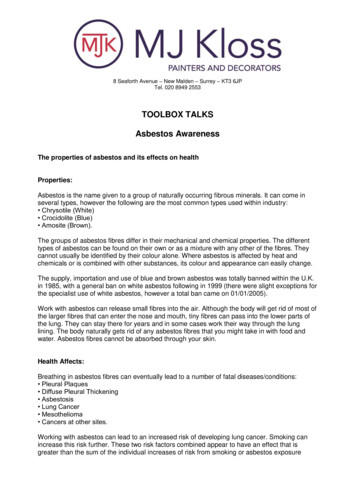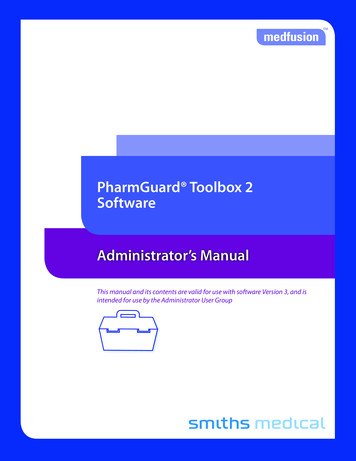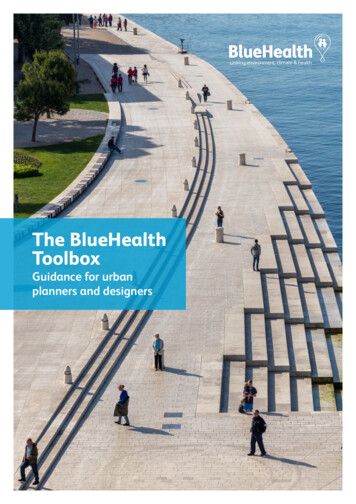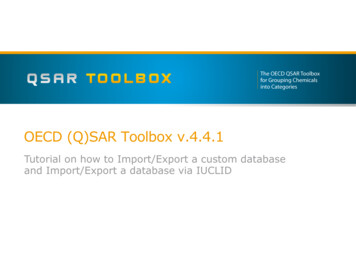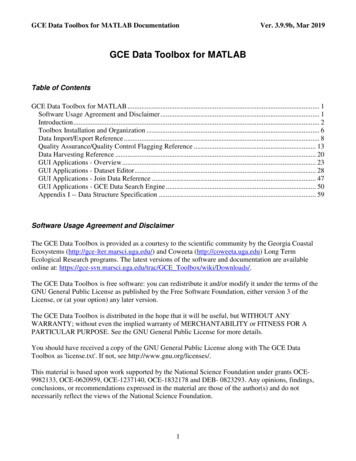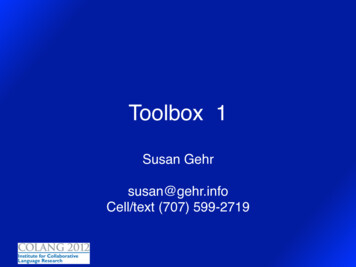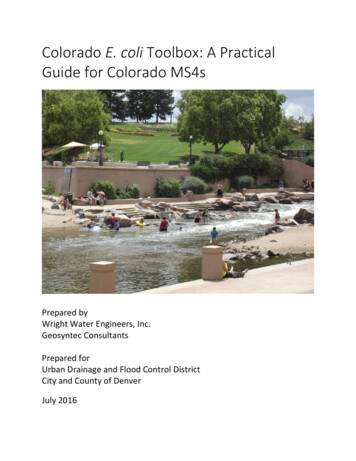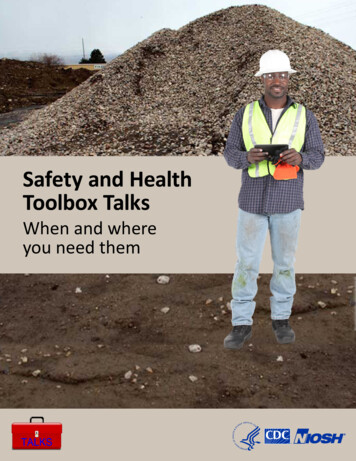
Transcription
Safety and HealthToolbox TalksWhen and whereyou need them
This document is in the public domain and may be freelycopied or reprinted.DisclaimerMention of any company or product does not constitute endorsement by NIOSH. In addition,citations to websites external to NIOSH do not constitute NIOSH endorsement of the sponsoringorganizations or their programs or products. Furthermore, NIOSH is not responsible for thecontent of these websites. All web addresses referenced in this document were accessible as ofthe publication date.Ordering InformationTo receive NIOSH documents or more information about occupational safety and health topics,please contact NIOSH:Telephone: 1–800–CDC–INFO (1–800–232–4636)TTY: 1–888–232–6348CDC INFO: www.cdc.gov/infoor visit the NIOSH website at www.cdc.gov/niosh.For a monthly update on news at NIOSH, subscribe to NIOSH eNews by visitingwww.cdc.gov/niosh/eNews.
Disclaimer of LiabilityThis NIOSH developed software is provided “AS IS” without warranty of any kind includingexpress or implied warranties of merchantability or fitness for a particular purpose. Byacceptance and use of this software, which is conveyed to the user without consideration byNIOSH, the user expressly waives any and all claims for damage and/or suits for personal injuryor property damage resulting from any direct, indirect, incidental, special or consequentialdamages, or damages for loss of profits, revenue, data or property use, incurred by you or anythird party, whether in an action in contract or tort, arising from your access to, or use of, thissoftware in whole or in part.No further development or upgrades for this software is planned. Any questions concerning thisproduct can be directed to the Office of Mine Safety and Health Research e-mail box atOMSHR@cdc.gov.
ContentsToolbox Talks Instructions . 1Slips and Falls . 3Ground Control . 5Lock-Out Tag-Out (LOTO) . 7Struck-by Injuries . 9Customer Traffic . 11Risks to Contractors . 13Nonroutine Tasks . 15Working at Heights . 17Taking Shortcuts. 19Seat Belts. 21Housekeeping . 23Powered Haulage . 25Stopping Work . 27Additional Resources . 29
Toolbox Talks InstructionsThis set of Toolbox Talks is based on results of a NIOSH research project on hazard perceptionand risk awareness at surface sand, stone, gravel, and aggregate (SSG&A) operations. NIOSHresearchers interviewed workers and recorded what they had to say about hazards and risks attheir worksite. The project team also analyzed accident and injury data that had been reportedto the Mine Safety and Health Administration (MSHA) to determine which hazards hadresulted in nonfatal and fatal injuries during the years 2009–2014. The goal for using these twodata sources was to identify hazards that SSG&A mine workers see as critical and then linkthose hazards to the MSHA nonfatal and fatal data to show that these identified hazards doresult in injuries.How to Use the Toolbox Talks:The Toolbox Talks materials provide support for brief presentations and discussions about aseries of safety and health hazards. For each topic, there is information that can first be read tothe audience. Each topic also includes several questions that can be used to guide briefdiscussions. During the discussions, workers are encouraged to relate the hazard covered totheir own work environments.The Toolbox Talks can be used one at a time for short safety or Toolbox Talks. Or they can beused as modules in a longer training session, such as annual refresher training. No trainingexpertise is needed by the presenter to run sessions with the guidance of this material.Each Toolbox Talk contains these sections:What we heard about hazard or risk. The first section describes something a worker saidabout the hazards or risks at their job. During interviews, researchers wrote down whatworkers identified as critical hazards and risks. The thoughts and stories presented in thetalks were taken from those notes.Is it really a risk? The hazard or risk is explored by analyzing data from the MSHA accidentand injury database. Fatal and nonfatal data are presented in order to show that mineworkers’ thoughts and experiences are consistent with the realities of accidents, injuries,and fatalities.The statistics are taken from: MSHA [2015]. Accident, illness and injury and employmentself-extracting files (part 50 data), 20092014. Denver, CO: U.S. Department of Labor, MineSafety and Health Administration, Office of Injury and Employment k/p50y2k.HTM. Data included are from the1
following: years 2009 through 2014, Canvass 5 & 6 (Stone, sand and gravel) which includescontractors, SIC 14460 (nonmetal canvass), sand, industrial, ground silica, quartz, andSubunits 3 (surface), 6 (dredge), & 30 (mills). Date accessed: September 2015.It really happens. In this section a specific fatality, injury, or near miss is presented as anexample to highlight an actual event that took place at a mine site. In order to provide themost appropriate example, NIOSH researchers discussed accidents and near misses withmine workers during the interviews and read MSHA reports of fatalities that occurred atSSG&A mines from 2009 through 2014. On some pages there is a "Source" button thatprovides a link to more information. An Internet connection is needed to access thatmaterial.Think about it. Each talk ends with questions that help those participating tie the hazard orrisk information to their worksite. The person conducting the talk can use these questionsto start a discussion that will make the information relevant to participating employees.Learn more. Links to additional resources are given for each Toolbox Talk. The links areprovided to direct safety professionals and workers to publicly available information thatcan be used to learn more about the topic or modified to create additional training tailoredto the specific worksite. An Internet connection is needed to access the materials throughthese links.2
Slips and Falls 1 of 2Slips and FallsWhat we heard about Slips and FallsA maintenance worker with 6 months of experience listed slips, trips,and falls as a critical hazard.Although he is new to mining, he knows that trip hazards can beunexpected and that if he sees something that could be tripped over,then he should move it.Clearing away tripping hazards is important for you and also for thenext person walking in that area.Is it really a risk?In 2014, 536 workers at SSG&A mines were hurt when they slipped orfell at work. Five of them died.If you look back at the years 2009–2014, you will find that 3,243workers were hurt by slips, trips, and falls and 11 of those workers werefatally injured at SSG&A operations.Were you one of the injured workers? If not, could it have been you?3
Slips and Falls 2 of 2It really happens.A mine worker with 3 years of experience was carrying a porta powerjack. He tripped on torch hoses and fell. When he fell, the jack fell andsmashed his finger.Tripping over hoses resulted in four lost days of work.Think about it. Where is someone most likely to slip, trip, or fall at thisoperation? Has someone been hurt here by slipping, tripping, or falling? How can you protect yourself from slip, trip, and fall injuries?Learn more.NIOSH has compiled a list of resources related to fall injury prevention in theworkplace. This list of resources includes links to research articles that are focusedon a better understanding of why slips, trips, and falls happen in the workplaceand recommendations for how to prevent slip, trips, and falls in the workplace.This list also includes a link to the NIOSH Ladder Safety App, which is useful foraddressing issues related to falls from height.4
Ground Control 1 of 2Ground ControlWhat we heard about Ground ControlA pit loader operator, who had 2 years of mine experience, told us thathe thinks about ground control hazards at work. He hadn't seen anyonehurt but he said, "You can look at the walls, though, and see where therock is shifting."At his operation, the rule is to stay 12 to 15 feet away from the highwallwhen working. According to their SOP,1 if the area is inactive, then theyare supposed to install a berm. But this safety precaution cannot betaken while they are actively loading.Is it really a risk?During 2009–2014, 35 mine workers were injured in accidents wherethere was a fall of side or highwall.During this same time period, 6 miners were killed because they eithergot too close to the highwall while working in the pit or were unawareof changes to stockpiles because of how material was removed.1SOP Safe Operating Procedure5
Ground Control 2 of 2It really happens.Two days before Thanksgiving in 2014 2, a truck driver backed his truckup to the edge of an overburden dumpsite and raised the bed to dumpthe load.The ground under his truck failed. The truck overturned and landedupside down 30 feet below the original dumping point.This driver, who had 10 ½ years of experience, died of his injuries onthe way to the hospital.Think about it. What type of ground control issues do you have to be aware ofwhere you work? What are signs of ground control problems? What do you look or listen for? What does your operation do to control ground stability? How can you protect yourself from unstable ground?Learn more.MSHA created a presentation discussing ground control at surface mines. Thepresentation is focused on highwall hazards and provides recommendations onhow to remediate them.2Source: s/fab-m22.asp6
Lock-Out Tag-Out 1 of 2Lock-Out Tag-Out (LOTO)What we heard about LOTOWhen talking about workers protecting themselves, a pit loaderoperator with 2 years of mining experience said, "You just have to makesure to follow rules like putting locks on for LOTO. Most people have alot of experience. They know not to do something like restartequipment or machines during maintenance or cleaning."Is it really a risk?In just 6 years (between 2009 through 2014), 13 workers at SSG&Aoperations died because equipment or machinery was not locked outand tagged out when they should have been.Four of the workers were killed because equipment, such as a belt, wasenergized by a co-worker who didn't realize maintenance was beingperformed on it at the time.It really happens.A worker with more than 10 years of experience talked about a timewhen he chose to not lock out, saying “One time I went up on thatchute and was shoveling material from the chute without having lockedit out. I knew I should have locked it, but I also knew there was no oneelse in that area of the pit. Nothing happened, but looking back, it wasa really bad decision. Yes, there was no one else in the area when I7
Lock-Out Tag-Out 2 of 2started the job, but someone could have driven over and turned thatbelt on while I was up there. I was standing on the belt shovelingmaterial. If someone had turned the belt on, it would have taken meright up the chute and dropped me out of the top and I would havefallen and probably died.”Think about it. What is the equipment maintenance lockout/tagout policy atyour mine site? Are there times when following your policy makes it difficult todo your job? Is there a way the policy could be changed to make the jobeasier, but also keep everyone safe?Learn more.NIOSH researchers have written a document titled "Using Lockout and TagoutProcedures to Prevent Injury and Death during Machine Maintenance." Thepurpose of this document is to provide employers, workers, and manufacturerswith strategies for effectively incorporating LOTO into work activities andequipment.In December 2010, a worker performing maintenance on a belt line was killedwhen the belt, which had not been locked and tagged out, was restarted while thevictim was standing on the belt conveyor.8
Struck-by Injuries 1 of 2Struck-by InjuriesWhat we heard about Struck-by InjuriesA primary crusher operator told us that he tries not to dump whenpeople are going from or coming to the shack because he doesn't wantany rocks flying out. He makes sure that nobody leaves the shack whiletrucks are dumping.This is a worry for him because he has a lot more to look out for andthe area can be very noisy. He said he would not be able to seesomeone walking up to the primary shack.Is it really a risk?From 2009 through 2014, 5,515 workers at SSG&A mines were hurtwhen they were hit by something they didn't expect to move. Some ofthese injuries were minor and only required first aid, but 2,778 wereserious enough to cause missed days of work and 21 miners werefatally injured.It really happens.Here are a few examples from MSHA injury reports of ways a workerwas injured when being struck by flying material. An employee was outside of his truck, loading material from a bin.It was windy outside and material falling onto the conveyor beltblew into his eyes, even though he was wearing safety glasses.9
Struck-by Injuries 2 of 2 Two employees were struck by flying material when the batteryexploded while they were jump starting an excavator. An employee was removing the cap to a fuel tank. There was aclogged vent that caused pressure to build up in the fuel tank. Thecap came loose and struck the employee in the face.It is important to always be aware of the objects and materials in yourwork environment.Think about it. Have you ever been hit by anything at work? If yes, what? What kind of falling or flying objects should you look out for atyour worksite?Examples: items from shelves in the shop, moving vehicles, androcks falling from a highwall How can you make it less likely that those objects will hitsomeone?Learn more.The Occupational Safety and Health Administration (OSHA) produced a trainingguide focused on increasing awareness of possible struck-by accidents. This guideincludes an explanation of struck-by accidents, exercises that can be used toincrease workers' awareness of them, and an evaluation tool to test the reader'sknowledge of how they occur.10
Customer Traffic 1 of 2Customer TrafficWhat we heard about Customer TrafficA haul truck driver with less than a year of experience is concernedabout hazards created by customer truck drivers. When asked aboutrisks on his job, he said, "Customer trucks are ranked #1 because Ispend a lot of time at the loading bins where the customer trucks are.The rule here is yield for equipment. 95% of the time they don't reallyyield.""I guess it just boils back down to the fact that you don't really knowwhat they are thinking and what they are going to do."A ground man with over 10 years of mining experience agreed and saidthat he needs to be very watchful of customer truck operators; he said,"They do stupid things, and they don't read the signs."There are two separate hazards when it comes to customer truckdrivers: (1) their driving on site, and (2) getting out of their vehicles.Is it really a risk?Customer truck operators do not have the same level of site-specificknowledge as the workers who are on site every shift.They likely do not have as much training about the need to be aware ofthe hazards associated with larger truck traffic and the risks of notabiding by the mine site's speed limit, not using proper PPE, and notfollowing the mine site's traffic pattern.11
Customer Traffic 2 of 2It really happens.While we were talking with a ground man, he had the opportunity toshow us his concern first hand.Right after telling us about the risk that customer drivers create formine employees and for themselves, he stopped our conversation sohe could get out of his truck and talk to a customer truck driver. Thisdriver had gotten out of his truck and was on top of the load on theback of the truck trying to redistribute the material by hand.In addition to being out of his vehicle when he wasn't supposed to be,he was now on top of the truck and he was not wearing any PPE.Think about it. Where do you see customer trucks on or near your workplace? What would you do if you saw a customer truck operator doingsomething that wasn't safe? Are there changes that could be made to customer traffic at youroperation that could increase your safety?Examples: change traffic patterns, put up better signs, anddesignate customer parking away from loading areasLearn more.The Michigan Mine Safety & Health Training Program created guidelines thatinclude information from Title 30 Code of Federal Regulations (56/57.9100 (a andb)) about signage requirements as well as what mine operators and equipmentoperators need to know about traffic control at a mine site.12
Risks to Contractors 1 of 2Risks to ContractorsWhat we heard about Risks to ContractorsA loader operator who had over 25 years of mining experience said thebiggest safety concern in his job is watching out for people around hismachine.He said, "Don't run into anyone, be careful backing up, make sure noone is behind you or passing."He highlighted his worry about contractors who drive trucks into theloading area, saying "At the scale, it is hazardous loading little truckswhen there are big trucks around. Contractor drivers are giveninstruction when they come on site. They are told they must stay intheir vehicles, but sometimes they get out."Is it really a risk?Of the 1,289 injuries to contractors at SSG&A mine sites for the years2009 through 2014, 16 were fatal.Seven of these fatalities happened while contractors were working in oraround mobile equipment such as haul trucks, tanker trucks, anddozers.From what we heard, it's always important to be aware of: (1) yoursurroundings and (2) others working near you.13
Risks to Contractors 2 of 2It really happens.After checking in at the mine guard shack at a cement operation, acontractor, who had 30 years of experience, drove his truck to amaterials storage building to deliver his load of fly ash. 3He got out of the truck to untarp the trailer. At the same time, a frontend loader operator was backing down a ramp from a nearby hopperhe had been filling.The front-end loader operator hit the truck driver and pinned himagainst the truck. This 51-year-old driver died of his injuries.Think about it. Who is at risk of being hurt around equipment at your site? Are contractors at more or less risk than other workers whooperate or work near equipment? Why? What other risks do contractors face?Learn more.MSHA issued a Fatality Alert to raise awareness of the risks contract workers faceat mine sites. This fatality alert includes best practices that can be used to increasethe health and safety of both contractor and mine employees.3Source: http://arlweb.msha.gov/fatals/2014/FAB14m16.asp14
Nonroutine Tasks 1 of 2Nonroutine TasksWhat we heard about Nonroutine TasksA ground man with over 10 years of experience told us, "If it is a big job,like a plant tear down, there is a lot of planning ahead of time, and weidentify all the potential hazards. We spend a lot of time on safetywhen it is a big job that we don't do very often. But it is still riskybecause we aren't all that experienced at those jobs, and hazards canjust pop up."Is it really a risk?In 6 years (between 2009 and 2014), 17 workers at SSG&A operationsdied as a result of being injured while doing what MSHA callsnonroutine tasks.A nonroutine task is one that isn't done often enough for the peopledoing the job to be completely familiar with it or one that must be doneaway from the area where they normally work.15
Nonroutine Tasks 2 of 2It really happens.In 2009, workers at a surface limestone mine were assigned to removean old aggregates plant. They were using a crane to remove a crusherfrom its base and had used double chain slings with grab hooks andwire rope bridles to secure it. 4The shift supervisor was working near the base of the crusher. A laborerwas passing information from him to the crane operator.When the crusher was lifted about 6 inches from its base, the boom ofthe crane twisted and fell. It hit and killed the 61-year-old laborer.Think about it. What are nonroutine tasks that have to be done at your operation? Is preparing to work safely during a nonroutine task different thanpreparing for a routine task? How do you prepare to do a task you do not perform very often?Learn more.The University of Chicago's Environmental Health and Safety Program gatheredinformation related to nonroutine jobs and tasks, which are jobs and tasks thataren't performed often enough to be completely familiar to the worker.This document includes recommendations for how to prepare for and avoidhazards associated with a nonroutine task.4Source: http://arlweb.msha.gov/FATALS/2009/FAB09m05.asp16
Working at Heights 1 of 2Working at HeightsWhat we heard about Working at HeightsA haul truck driver with less than a year of experience said this aboutthe risk of falling from heights, "If you think you are too high, you canalways put a harness on or just be extra careful."Do you agree?Is it really a risk?From 2009 through 2014, there were 2,304 miners injured and 13workers were killed when they fell from some height at a SSG&Aoperation.In every case, the fatality could have been prevented by the correct useof fall protection.It really happens.A ground man with over 10 years of mining experience shared a safetyslip up.He said, "On a daily basis I am safe, but there are some things I getcomplacent with. For example, I sometimes shovel the chutes withoutgloves on and sometimes I step or stand on the hand rails, and I don'talways wear my hearing protection. Working at heights, especiallylower heights, but still above the MSHA rule, is a big issue for me.17
Working at Heights 2 of 2Sometimes I can stand on a guard to reach something instead of goingand getting a man lift. This means that the job takes 5 minutes insteadof 15 minutes."Think about it. What tasks do you do as a normal part of your job that requireusing fall protection? At this operation, what situations are most likely to lead tosomeone falling from a height? What changes could be made to better protect workers from therisk of falling?Learn more.MSHA issued a fatality alert that raises awareness of the dangers of working atheights. A maintenance mechanic was working at a 16-foot height at a crushedstone operation and fell through a missing railing on an elevated walkway. He wasnot wearing fall protection.18
Taking Shortcuts 1 of 2Taking ShortcutsWhat we heard about Taking ShortcutsA mobile equipment operator with over 26 years of experienceexplained one reason why people get hurt at work, "When you see thepeople get hurt, it's because they get in a routine of doing the samethings all the time. They don't stop and think. They think that littleshortcut is going to help them and it don't."Is it really a risk?Shortcuts may save you time now, but they can cost you a lot morethan a few minutes of your time later.During the six years from 2009 through 2014, 70 miners died at stone,sand, gravel and aggregate mine and quarry sites.Many of them took a shortcut. They didn't take the time to de-energize,lockout and tagout the equipment they were working near or theydidn't go and get the necessary PPE for the job. They didn't chock theirwheels or use the appropriate block for the task. Often they didn'tfollow the safe operating procedure (SOP) to make sure the job wasdone correctly.19
Taking Shortcuts 2 of 2It really happens.A mobile equipment operator told us about maintenance work that wasdone on a pump the previous day. He told us, “The right way means noshortcuts. I guess just sticking it together for the time being becausethat could, you know We (just saw) that yesterday. There was a pumpthat broke loose and I would say that was probably from not doing itthe right way the first time, just slapping it together to keep going, andnobody ever went back to check it. . If you don’t do it the right way,you would have even more lost time later on.”Think about it. What shortcuts have become bad habits at this worksite? Are there changes that can be made to make jobs easier withoutdangerous shortcuts? What can you do to discourage your coworkers from takingshortcuts that put them and you at risk?Learn more.Workers at your site may be tempted to take shortcuts to get a job done faster.The following link provides examples of situations where a worker took a shortcut.These examples can be used to start a discussion about the possible consequencesof taking a shortcut.You can also the discuss the event where a 54 year old truck driver working at alimestone mine climbed a stack of loaded pallets to get to planks that were storednear the rafters. He fell 8 feet to the ground below and was killed. Instead of goingto get a ladder and fall protection to ensure his safety, the miner took a short cut.20
Seat Belts 1 of 2Seat BeltsWhat we heard about Seat BeltsYou don't forget the time someone died at your worksite.A man who typically works in the shop but also occasionally works inthe quarry, talked about a fatality that had happened where he workedthat resulted from a coworker not wearing his seatbelt."A low or unstable berm could have been the cause of the one fatalityon site, which happened many years ago. What actually killed him wasnot being belted in."Is it really a risk?Six SSG&A mine workers were fatally injured, between 2009 and 2014,because they were not wearing their seatbelts while operatingpowered haulage equipment.It really happens.In September of 2013 at a crushed stone operation, a haul truckerdriver was taking a load of broken rock to the primary crusher. 55Source: http://arlweb.msha.gov/FATALS/2013/FAB13m11.asp21
Seat Belts 2 of 2He made a sharp left turn and then crossed the haul road. He thendrove through the berm on the edge of the roadway. As the truck wentover the edge of the road, he was ejected and killed.This driver, who had over 25 years of mining experience, was notwearing his seatbelt.Think about it. Do you always remember to buckle up before starting yourequipment? Are all the seatbelts on site in good operational condition? What happens if someone doesn't wear a seatbelt on site? Do all of your friends and family members always wear seatbelts? If not, why not? What can you do to make them safer whenin a moving vehicle?Learn more.Workers not wearing seatbelts while operating haul trucks is a critical issue. Thefollowing link discusses recent fatalities that may have been avoided if theoperator had been wearing a seatbelt and provides talking points that can be usedto probe workers about why they might not be wearing seatbelts.22
Housekeeping 1 of 2HousekeepingWhat we heard about HousekeepingA safety trainer with over 26 years of mining experience said, "Thegreatest threat at a mine site is from housekeeping. It poses a greaterrisk because it is never done. There isn't a meticulous wife whowouldn't say something else can be done."Is it really a risk?Poor housekeeping creates hazards at a mine site. Even small items outof place should be taken care of as soon as possible.Be on the lookout for a buildup of material on walkways, stairways, orthe beltline. Excess material on walkways and stairways can cause tripsand falls. It can also fall on you as you walk under catwalks.Back or shoulder injuries can come from shoveling large amounts ofspillage and hand injuries from not wearing the right gloves when doingcleanup.It really happens.Here are a couple of examples from MSHA reports of injuries thatoccurred when housekeeping was neglected at a worksite. As a worker was unloading panels from a truck, he stepped onrocks that had accumulated in the area. He twisted his ankle andknee and then fell to the ground.23
Housekeeping 2 of 2 While shoveling mud and stones from a walkway that wasneglected in routine cleanup, a worker heard a pop and starteddeveloping pain in his left shoulder. A worker was shoveling clinker out of a walkway. He hurt his backwhen he lifted the full shovel and twisted his body to empty itinto a chute 4 feet from the floor.In each case, earlier, routine cleanup may have pr
The Toolbox Talks can be used one at a time for short safety or Toolbox Talks. Or they can be used as modules in a longer training session, such as annual refresher training. . and injury database. Fatal and nonfatal data are presented in order to show that mine workers’ thoughts
